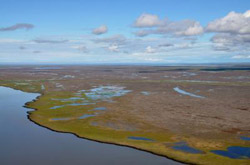Striking ecological impact on Canada's Arctic coastline linked to global climate change

Dead vegetation killed by the 1999 storm surge is in stark contrast to the vegetation along the edges of waterways that receive regular freshwater (and thus survived the damage). Credit: Trevor Lantz, University of Victoria<br>
“One of the most ominous threats of global warming today is from rising sea levels, which can cause marine waters to inundate the land,” says the team's co-leader, Queen's graduate student Joshua Thienpont. “The threat is especially acute in polar regions, where shrinking sea ice increases the risk of storm surges.”
By studying growth rings from coastal shrubs and lake sediments in the Mackenzie Delta region of the Northwest Territories – the scene of a widespread and ecologically destructive storm surge in 1999 – the researchers have discovered that the impact of these salt-water surges is unprecedented in the 1,000-year history of the lake.
“This had been predicted by all the models and now we have empirical evidence,” says team co-leader Michael Pisaric, a geography professor at Carleton. The Inuvialuit, who live in the northwest Arctic, identified that a major surge had occurred in 1999, and assisted with field work.
The researchers studied the impact of salt water flooding on alder bushes along the coastline. More than half of the shrubs sampled were dead within a year of the 1999 surge, while an additional 37 per cent died within five years. A decade after the flood, the soils still contained high concentrations of salt. In addition, sediment core profiles from inland lakes revealed dramatic changes in the aquatic life – with a striking shift from fresh to salt-water species following the storm surge.
“Our findings show this is ecologically unprecedented over the last millennium,” says Queen's biology professor and team member John Smol, Canada Research Chair in Environmental Change and winner of the 2004 NSERC Herzberg Gold Medal as Canada's top scientist. “The Arctic is on the front line of climate change. It's a bellwether of things to come: what affects the Arctic eventually will affect us all.”
Since nearly all Arctic indigenous communities are coastal, the damage from future surges could also have significant social impacts. The team predicts that sea ice cover, sea levels and the frequency and intensity of storms and marine storm surges will become more variable in the 21st century.
Other members of the team include Trevor Lantz from the University of Victoria, Steven Kokelj from Indian and Northern Affairs Canada, Steven Solomon from the Geological Survey of Canada and Queen's undergraduate student Holly Nesbitt. Their findings are published in the prestigious international journal Proceedings of the National Academy of Sciences.
Research funding comes from the Natural Sciences and Engineering Research Council of Canada (NSERC), the Polar Continental Shelf Program, the Cumulative Impact Monitoring Program, and Indian and Northern Affairs Canada.
Queen's School of Policy Studies Director Peter Harrison will chair the pivotal wrap-up conference of International Polar Year, From Knowledge to Action, to be held in Montreal in 2012.
PLEASE NOTE: A PDF copy of the Arctic coastline study, plus high resolution images, are available upon request. Contacts: Nancy Dorrance, 613.533.2869 nancy.dorrance@queensu.ca Queen's University News and Media Services
Lin Moody, 613-520-2600, ext. 8705 lin_moody@carleton.ca Carleton University Department of University Communications
Media Contact
More Information:
http://www.queensu.caAll latest news from the category: Ecology, The Environment and Conservation
This complex theme deals primarily with interactions between organisms and the environmental factors that impact them, but to a greater extent between individual inanimate environmental factors.
innovations-report offers informative reports and articles on topics such as climate protection, landscape conservation, ecological systems, wildlife and nature parks and ecosystem efficiency and balance.
Newest articles

Properties of new materials for microchips
… can now be measured well. Reseachers of Delft University of Technology demonstrated measuring performance properties of ultrathin silicon membranes. Making ever smaller and more powerful chips requires new ultrathin…

Floating solar’s potential
… to support sustainable development by addressing climate, water, and energy goals holistically. A new study published this week in Nature Energy raises the potential for floating solar photovoltaics (FPV)…

Skyrmions move at record speeds
… a step towards the computing of the future. An international research team led by scientists from the CNRS1 has discovered that the magnetic nanobubbles2 known as skyrmions can be…





















